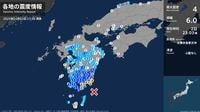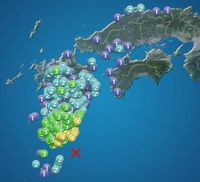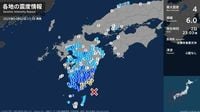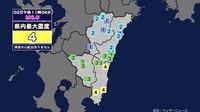On April 2, 2025, at precisely 11:04 PM JST, residents of Miyazaki and Kagoshima prefectures experienced a relatively strong earthquake that registered a maximum seismic intensity of 4. According to the Japan Meteorological Agency (JMA), the earthquake's epicenter was located off the east coast of the Osumi Peninsula, at a depth of approximately 40 kilometers, with a magnitude estimated at 6.0.
The tremors were felt in several cities across the region, including Miyazaki City, Nichinan City, and Kushima City in Miyazaki Prefecture, as well as Kanoya City and Shibushi City in Kagoshima Prefecture. Reports indicated that the earthquake was strong enough to cause alarm among residents, prompting many to check on their neighbors and seek information about possible aftershocks.
Despite the quake's intensity, officials reported no immediate concerns regarding a tsunami, which often accompanies seismic activity in coastal regions. The JMA reassured the public that while the earthquake was significant, the risk of a tsunami was negligible, allowing residents to breathe a sigh of relief amidst the initial panic.
In Miyazaki Prefecture, several municipalities experienced the seismic activity firsthand. Cities such as Miyazaki, Nichinan, and Kushima reported feeling the tremors, while in Kagoshima, Kanoya and Shibushi were among the affected areas. The earthquake's impact extended beyond these cities, with tremors felt as far away as Saga and Kumamoto Prefectures, where seismic intensities of 3 were recorded.
Residents took to social media to share their experiences, with many expressing their surprise and concern over the sudden quake. "I was just settling down for the night when everything started shaking. It was quite frightening," said a resident of Miyazaki City. Others reported that their pets reacted nervously, sensing the disturbance before it occurred.
As emergency services began assessing the situation, local authorities urged residents to remain cautious and prepared for potential aftershocks. They advised people to secure heavy furniture and stay away from windows, which could shatter during subsequent tremors. Fortunately, there were no immediate reports of significant damage or injuries, but officials remained vigilant as they monitored the situation.
The JMA also noted that this earthquake was part of a broader pattern of seismic activity in the region, which is known for its geological volatility. Japan, being located on the Pacific Ring of Fire, frequently experiences earthquakes, and local authorities are trained to respond swiftly to ensure public safety.
As the night progressed, many residents continued to stay awake, discussing their experiences and checking in on one another. Community spirit was evident, as neighbors offered support and shared updates on the situation. "It's times like these that we come together as a community," remarked a local shop owner, who opened his store to provide refreshments to those who were shaken by the event.
In the aftermath of the quake, officials began reviewing their emergency preparedness plans to ensure that they were adequately equipped for future seismic events. Drills and educational programs aimed at teaching residents how to respond during an earthquake are crucial components of these efforts, helping to mitigate panic and ensure safety.
As dawn broke over Miyazaki and Kagoshima, residents began to assess the situation more thoroughly. While the initial shock of the earthquake had passed, many remained on alert for aftershocks, which can occur days or even weeks after the initial event. The JMA continued to provide updates, assuring the public that they were closely monitoring seismic activity in the area.
In a statement, the JMA emphasized the importance of preparedness, stating, "We encourage all residents to have an emergency kit ready and to know the safest places in their homes to take shelter during an earthquake." This advice serves as a reminder of the unpredictable nature of seismic events and the need for ongoing vigilance.
As the day unfolded, local news outlets began reporting on the earthquake, providing updates and safety tips for residents. Many expressed gratitude for the preparedness measures that had been put in place, which likely helped to minimize panic and ensure a swift response from emergency services.
In conclusion, while the earthquake on April 2, 2025, was a significant event for residents of Miyazaki and Kagoshima, the community's response highlighted their resilience and preparedness. As they navigate the aftermath of this seismic event, the lessons learned will undoubtedly shape their approach to future emergencies.





